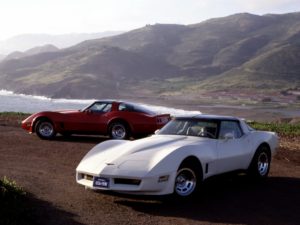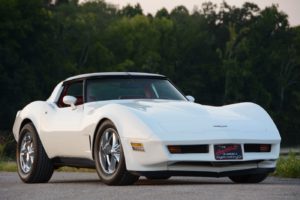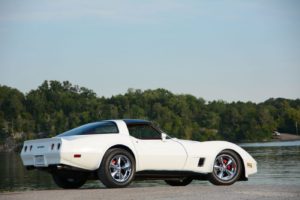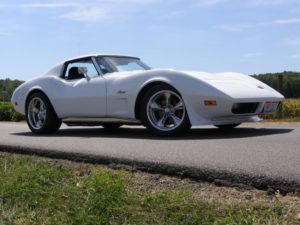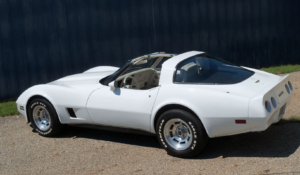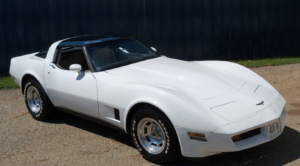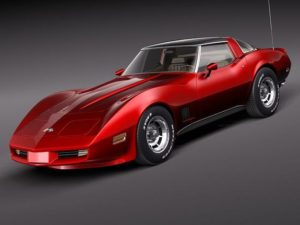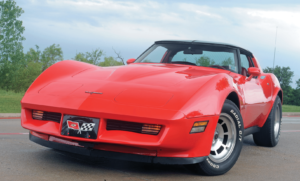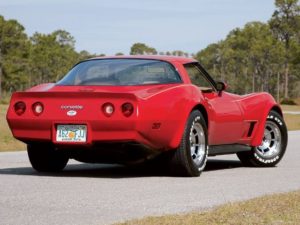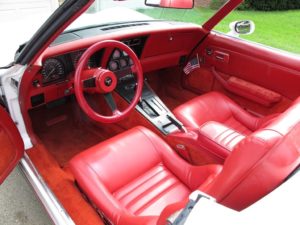The arrival of the 1980 Chevy Corvette came on the heels of another fuel crisis that had impacted the American automotive market – and, more generally, the national economy – as a whole.
Much like the fuel crisis of the early seventies, when the 1973 Arab Oil Embargo had cutoff petroleum exports to many parts of the world, a second energy crisis had emerged after the Shah of Iran was overthrown during a revolution that had occurred in that country – and the results were nearly the same.
The United States, in response to the 1973 OPEC embargo on petroleum, had enacted CAFE (Corporate Average Fuel Economy). CAFE had aimed to improve the average fuel economy of cars and light trucks sold throughout the U.S. Now, given the continued upheaval in the Middle East and the resulting increase to petroleum prices, new CAFE standards were being implemented. This meant the Corvette would have to be put on a “diet” if it was to continue being a viable production vehicle.
Pricing: $14,345.24 (Coupe)
Engine: 350ci, 190HP Engine (standard), 350ci, 230HP Engine, 305ci, 180HP Engine (California)
Transmission: 4-speed manual (standard), 3-speed Turbo Hydra-Matic automatic (optional)
Top speed: 85mph
Units Produced: 40,614
Available Colors: White, Silver, Black, Dark Blue, Dark Brown, Yellow, Dark Green, Frost Beige, Dark Claret, Red
Highlights of the year:
In response to the CAFE mandate, Chevrolet decided that the first-stage of trimming back the Corvette would mean the elimination of some 250 pounds from the current design. Engineers considered every option to lighten the car’s structure while trying to maintain its structural integrity.
Externally, engineers trimmed weight by using lower density roof panels, and by reducing the material thickness of the hood and the outer door skins.
Exterior chrome was kept to a minimum, which meant the elimination of the crossed-flag emblems from the front fenders. Lastly, greater use was made of plastics throughout the car on everything from interior trim components to sub-assemblies in seats, and so on.
In addition to weight reduction measures, engineers also focused on getting the Corvette to produce better overall gas mileage results. The previously optional front and rear spoilers were reshaped and made an integral part of the bodywork. Additionally, the front grilled was raked back slightly. As a result of these changes, the coefficient of drag (Cd) fell from 0.503 to a more respectable 0.443. While this number was still not optimal, it was a notable improvement nonetheless.
Mechanically, the 1980 Corvette suffered some because of increasingly stringent emissions regulations. The base L48 engine, which had been rated at 195 horsepower in 1979, lost five bhp as a result of emissions tuning – taking it back to 190HP at 4,400rpm and 280lbs/ft. of torque at 2,400rpm. Worse was the impact that California emission standards had on the Corvette.
Outwardly, the Corvette received few design changes, save for the aforementioned front and rear spoilers, the raked-back grill, and the removal of the Corvette emblems from the side fenders. However, the Corvette emblem itself was modified some and now featured a new, more elongated design. Additionally, the hood featured a lower profile, and new cornering and taillights were introduced.
Inwardly, a number of other changes were implemented, many of which were the result of either Federal requirements or the need to make cosmetic changes as a result of functional improvement. To start, the speedometers of all 1980 Corvettes now showed a maximum speed of just 85 miles per hour. Although this change had started being phased into the Corvette in some of the late 1979 production models, it was now a federal requirement for all 1980 models – presumably in response to the newly imposed 55 miles-per-hour mandatory speed limit that had been put in place on interstates across the country.
Additionally, power windows, air conditioning and tilt/telescopic steering were made standard options, a new ribbed-pattern cloth interior was introduced, a side-shield was added to the driver side sunvisor to reduce sun glare, and the power door lock buttons were relocated to increase operator convenience.
Chevrolet sold 40,614 Corvettes in 1980, which was roughly a 20 percent decline in sales from the 1979 model year
Press and public opinion of the 1980 Corvette remained divided. For some, the car continued to impress with its more-than-respectable performance numbers. The 1980 Corvette clocked 0-60mph times at between 7.1 and 7.7 seconds (when equipped with the L82.)
However, others criticized the measure that had been taken to lighten the Corvette, and the overall emphasis on fuel efficiency.
Perhaps the greatest criticism of the Corvette as a whole was the fact that the C3 production continued on, when clearly it was time for Chevrolet to introduce a new generation of Corvette, or perhaps abandon the program entirely.
However, given the sales numbers of the 1980 Corvette, there were few who believed that the Corvette would go anywhere – which reinforced the belief amongst enthusiasts and critics alike that a next-generation model was imminent.
Photos of the 1980 Corvette:
Sources:
https://www.corvsport.com/the-c3-corvette/
https://www.corvsport.com/1980-c3-corvette-image-gallery/
